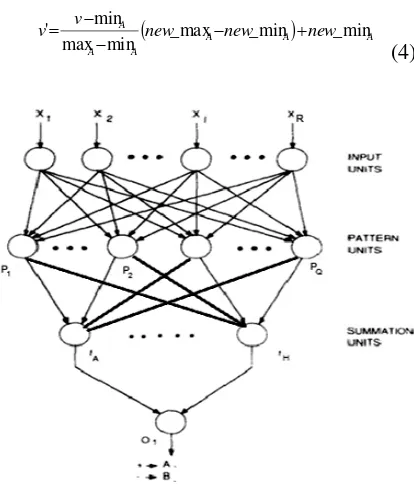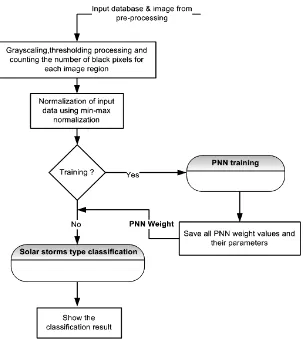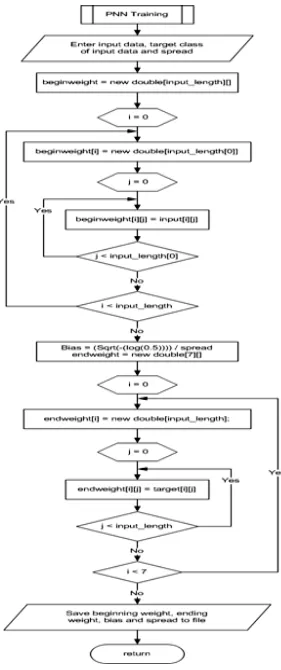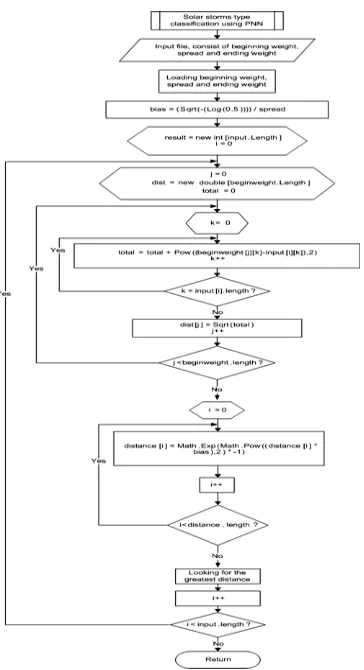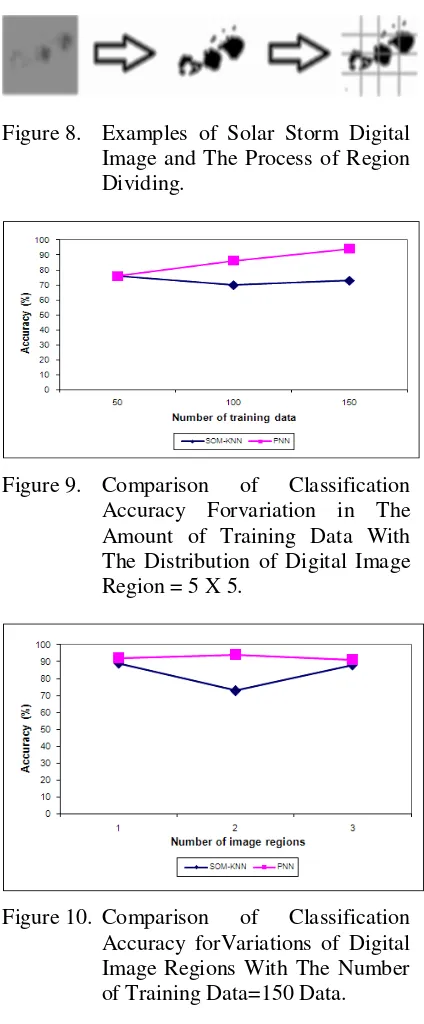211
SOLAR STORM TYPE CLASSIFICATION USING PROBABILISTIC
NEURAL NETWORK COMPARED WITH THE SELF-ORGANIZING
MAP
a
Gregorius S. Budhi,
bRudy Adipranata
, c
BambangSetiahadi,
dAdrian H. N.
a,b,dInformation Engineering Department, Petra Christian University,Siwalankerto 121 – 131, Surabaya
cAerospace Observer Station (SPD) LAPAN,
Watukosek, Gempol, POBox 04, Pasuruan E-Mail: a[email protected]
Abstrak
Salah satu tugas LAPAN adalah melakukan pengamatan dan peramalan gangguan badai matahari. Gangguan ini dapat mempengaruhi medan elektromagnet bumi sehingga mengacaukan peralatan elektronik dan navigasi yang ada di bumi. Hal ini akan dapat membahayakan kehidupan manusia bila tidak diantisipasi dengan benar. LAPAN menginginkan adanya aplikasi komputer yang secara otomatis dapat mengklasifikasi tipe badai matahari, yang menjadi bagian dari sistem early warning yang akan dibuat. Oleh sebab itu kami dari Universitas Kristen Petra program studi Teknik Informatika dan Lembaga Penerbangan dan Antariksa Nasional melakukan penelitian bersama tentang klasifikasi badai matahari. Klasifikasi dilakukan terhadap citra digital badai matahari / kelompok bintik matahari ini berbasis pada sistem klasifikasi ”Modified - Zurich Sunspot Classification” yang banyak digunakan. Metode klasifikasi yang kami gunakan disini adalah Jaringan Saraf Tiruan Probabilistik. Hasil dari pengujian cukup menjanjikan karena memiliki akurasi sebesar 94% untuk data testing. Akurasi ini lebih baik dari akurasi aplikasi serupa yang dibangun dengan kombinasi metode Self-Organizing Map dan K-Nearest Neighbor.
Kata kunci: Klasifikasi Tipe Badai Matahari, Sistem Klasifikasi Modified - Zurich Sunspot Classification, Jaringan Syaraf Tiruan Probabilistik.
Abstract
One of the task of the LAPAN is making obsevation and forecasting of solar storms disturbance. This disturbances can affect the earth's electromagnetic field that disrupt the electronic and navigational equipment on earth. It would be dangerous to human life if not properly anticipated. LAPAN wanted a computer application that can automatically classify the type of solar storms, which became part of early warning systems to be created. Therefore we from Petra Christian University Informatics Engineering Department and the Indonesian National Aeronautics and Space Agency conduct joint research on the classification of solar storms. The classification of the digital images of solar storm / sunspot groups is based on “Modified - Zurich Sunspot Classification System” which is widely used. Classification method that we use here is the Probabilistic Neural Networks. The result of testing is promising because it has an accuracy of 94% for testing data. The accuracy is better than the accuracy of similar applications we've built with a combination of methods Self-Organizing Map and K-Nearest Neighbor.
INTRODUCTION
Disruption from the sun that recently known as solar storm is strongly concerned. The disruption can affect the Earth's electromagnetic field, in addition to others dangers that can be happening. Today, human life is highly dependent on modern technologies especially in the field of electrical, electronics, computer and navigate the sea and air, that are susceptible to interference from electromagnetic field changes. Therefore, the emergence of 'interference' from solar storms should be anticipated quickly and precisely.
Actually the solar storm term is a great explosion (Flare) and Coronal Mass Ejection / CME on the surface of the sun. Before the famous term solar storm, this two type of disruptions is more commonly called a group of sunspots, because that's the kind seen in the image of the sun taken by the Michelson Doppler Image instruments (MDI) Continuum / SOHO (Solar and Heliospheric Observatory). Sunspots evolved from a tiny spot with low activity evolved into a very complex configuration with the possibility of having high activity, which issued a mass explosion and hurling corona. To determine the level of complexity of sunspots and sunspot activity Modified - Zurich classification is used in order to classify the types of sunspots.
This study is part of a larger study entitled "Automated Sunspot Group Classification for Analyzing Space Weather Conditions" we've done in collaboration with researchers from the National Aeronautics and Space Agency (LAPAN). Classification of sunspots groups is based on Modified - Zurich Sunspot Classification system. In this paper we publish some of the results of our study that is the use of probabilistic neural network to the classification of sunspots groups / solar storms type, which looks at the digital image of the sun.
Before the classification process, it is
necessary proceeding digital
imageenhancement ofthe sun images. It should also detect the location of sunspots and sunspot groupings. All of our process has been published previously [1, 2].
For the testing, we also compared the results of this sub-system testing with other classification sub-systems that we have made
previously by using a combination of artificial neural network method Self-Organizing Map and data mining methods K-Nearest Neighbor [3]. This comparison purposes so that we can obtain the most appropriate classification method to be used in the classification system of solar storms that will be created.
SUNSPOT CLASSIFICATION
Sunspots are the intersection of the solar magnetic flux tube with the photosphere.
Sunspots appear dark because the magnetic field has the effect of sunspot cooling so that the temperature is lower than the surrounding area. The magnetic field of sunspots proved to be a source of disturbance energy from the sun, such as explosives, or hurling coronal mass [4]. The latter phenomenon known as solar storms can disrupt space environment around the Earth and technology facilities and life on the Earth's surface [5, 6, 7].
Figure 2. Detail Architecture of PNN [13].
Figure 3.PNN Architecture [14].
Because of the sunspot's magnetic field is the intersection of the tube with the photosphere, the appearance of sunspots begins with a small black spot.Over time, if the tube magnetic field is constantly out of the sun due to the buoyant force, it would appear two spots with opposite magnetic polarity (bipolar). Sunspots evolved into more complex configurations, in example, the number of spots and area increases. The more complex a configuration of sunspots are, the greater the possibility of instability magnetic field that triggers a flare or CME events [8, 9].
Stages of the evolution of sunspots is expressed in the "Modified - Zurich Sunspot Classification", namely class A, B, C, D, E, F (the level of complexity increases) and then gradually decreased until it became a class H. Image of the sunspot evolution classification found in Figure 1 [10].
ARTIFICIAL NEURAL NETWORKS
Artificial neural network is a processing model that is based on the workings of the human brain [11]. Just like the human brain, neural
networks composed of cells interconnected neurons. Each cell is a neuron receives input signals are processed to produce an output signal. Neural networks can learn to like the human brain by giving weight for each input on neuron cells. By using weights, the neural network can learn a given input.
Probabilistic Neural Network
Probabilistic Neural Network (PNN) is a method of artificial neural networks using the principles of statistical theory Bayesian Classification to replace heuristic principles used in the Back-propagation algorithm [12]. layer as can be seen in Figure 2 [13].
The inputlayerdoes notperformany
calculations, justtransfer the datainput toeachneuronin thepatternlayer.Eachneuronin thepatternlayerwillperformprobability
calculations(distance) between theinputsto thedata storedin thepatternlayerneurons.
Furthermore, thesummation layer
willreceiveinputfromneurons of pattern layerand sum it. Andlast, the outputlayerwill produceclassification resultsbased on the resultsof thesummationneuronthat hasthe
greatestvalue. In
general,probabilisticneuralnetwork architectureis shown inFigure 3.
Here is the training algorithm of probabilistic neural network [14]:
1. Initializing initial weight (radial basis layer weight) W obtained from the transpose of the matrix R x Q where R is the dimension of input and Q is the number of training data.
2. Initializing constant spread (s) of PNN. 3. Initializing the bias weight (b), as shown in
Equation (1),
= √ . (1)
values will be worth 1 if the training data into the group, otherwise it will be 0.
5. Calculate the distance between the vectors competitive function C where the competitive function will locate the largest value in the vector d. Index of greatest value is to indicate the results of the classification of data input P. of this method is shown in Equation (4).
A A
AFigure 4. PNN Architecture Used.
DESAIN OF SOLAR STORM
CLASSIFICATION SUB-SYSTEM
Probabilistic Neural Network Architecture Used
Probabilistic neural network architecture used is shown in Figure 4.
For the number ofinputunitswill be obtainedfrom the largedimension ofthe data input(R), theprocessed datafrom the databaseinputdiameter, area, perimeter, number
ofsunspotseach group, and the
averageblackpixelforeachregionof the input image. After that, eachinputunitis connected toall thepatternunitsamountingtoaweightQ, where Qis the amount oftraining data. So theinitialweightmatrixsizeQxR.
Each pattern unit will generate a value of the distance between the weight and the input, the result is a matrix dimension Q x 1 which will then be used for further calculations using radbas() function.
Each pattern unit will be connected with all summation units through the final weight, the j th column matrix valueswill be worth 1 if the training data into the group, otherwise it a result of the classification.
Sub-System Design
In Figure 5, 6 and 7 can be seen a block diagram and flowchart of the design sub-systems that are built for the solar storms type classification using probabilistic neural network method.
the input digital image is a digital image of the solar storm as shown in Figure 8. Furthermore, the solar storm digital image is converted to data that can be received by the input neurons of PNN. To change, the image is processed into black and white image using the grayscale processing and thresholding method. After becoming a black-and-white image,it is proceededto devide of regions in the image, where the number of regions specified by user. Examples of the process can be seen in Figure 8. Furthermore, the number of black pixels in each region is counted.
Next is the process of normalization of all the input data, using the Min -Max Normalization formula. These data are the area, perimeter, diameter, number of spots and values derived from counting the black pixels of each region. The values that have been normalized are used for input neurons PNN.
Once all the input data has been prepared, the user can select the process to be executed, namely: ANN training or classification. For
training the neural network, as in general the process of training the PNN method, all sample data will be processed to update all the weight until convergent. After converging, the weight is stored and can then be used in the classification process. The process of training for a sample data is shown in Figure 6.
For the classification process, input required is a set of PNN weights that have been convergent, PNN architecture used during training, and image the solar storms that will be classified. With passing the solar storms image to be classified in the sub-system of PNN (with a weight that has converged), we will get the value of the classification based on Modified - Zurich Sunspot Classification, which is a class A, B, C, D, E, F or H. The process of classification for a data can be seen in Figure 7. From the results of this classification can be determined quickly whether a solar storm (sunspot groups) is dangerous or not. Class types to be concerned are D, E and F.
Figure 8. Examples of Solar Storm Digital Image and The Process of Region Dividing.
Figure 9. Comparison of Classification Accuracy Forvariation in The Amount of Training Data With The Distribution of Digital Image Region = 5 X 5.
Figure 10. Comparison of Classification Accuracy forVariations of Digital Image Regions With The Number of Training Data=150 Data.
Table 1. The Constant Variation Spread Testing.
Note: The testing data are samples data that did not participate in the training process.
Table 2. Testing Variations in The Amount of Training Data.
Table 3. Regions Number Variations Testing.
The
There is some testing that has been done on the sub-systems, namely:
a. Testing the speed of the training and qualification process. It would be tested with a maximum total data that we have (214 kinds of sample data). Test results state that each process has a speed less than 0.1 milliseconds. It can be concluded that in terms of processing speed, the sub-system is very good.
b. Tests with constant variation spread of PNN. The test is performed with the number of training data=150 data and digital images of solar storms that is divided into 5 x 5 regions. The test results can be seen in Table 1. So, we could conclude that the higher spread value will be, the decrease of classification accuracy value would be produced.
d. The next test is to vary the number of regions of the solar storm digital image that are processed. The test is performed with the number of training data = 150 data and the constant spread = 0.2. The test results are shown in Table 3.
The test results stated that for the classification of the training data, the best regions number is 7x7. However, if the classification performed on the data testing, the best regions number is 5x5.
Further, we will compare this sub system with similar sub-system that we have built previously used a combination of methods Self-Organizing Neural Network and K-Nearest Neighbor [3]. Testing variations spread constants cannot be compared because the constant spread only on PNN and not used in the SOM. In comparison of the speed of the training process, the PNN method was much better. Speed the process of training the SOM-KNN is still above 1 second for as many as 50 pieces of training data, while the PNN has speed training under 0.1 milliseconds for maximum training data (214 training data). Furthermore, the results of comparison of the classification accuracy of PNN and SOM-KNN can be seen in Figure 9 and 10.These accuracy comparisons are performed only on the data testing (sample data that not used during training).
From the results of the comparison between the solar storms type classification sub-systems built with PNN and SOM-KNN, it appears that the performance of the PNN sub - system was better.
CONCLUSION
Solar storm type classification sub-system using Probabilistic Neural Network has been created properly. It can be seen from the rapid process of training and classification, as well as the high level of classification accuracy. Besides that the sub-system has also proven to have a better performance compared to the similar sub-system that has been built previously using a combination of Self-Organizing Map and K-Nearest Neighbor methods.
However, we have not decided yetwhether the sub-system will be used or not. The test results must be compared with the results of similar system test that we built using Feed-Forward Back-propagation method. From the comparison result, analysis and further testing, we will determine which sub-system to use.
ACKNOWLEDGMENT
The research was funded by Research Competitive Grant DIPA-PT Coordination of Private Higher Education region VII, East Java (0082/SP2H/PP/K7/KL/IV/2011) fiscal year 2011 and Research Center, Petra Christian University, Surabaya (12/Sugas-Pen/LPPM-UKP/2012), fiscal year 2012, entitled "Automated Sunspot Group Classification for Analyzing Space Weather Conditions".
DEDICATION
We dedicate this paper to a co-researcher from the National Aeronautics and Space Agency (LAPAN), namely: Dr. Bachtiar Anwar M.Sc. who had died of illness at the end of 2011.
REFERENCES
[1] Adipranata R, Budhi GS, Setiahadi B, dan Anwar B.Segmentation of Sunspot Group using Watershed Method. Proceedings of the National Conference of System and Informatics. Bali. 332-337. 2010.
[2] Budhi, GS, Adipranata R, Sugiarto M, Anwar B, dan Setiahadi B. Sunspot Grouping of Solar Digital Image using
DBSCAN Clustering Method.
Proceedings of the National Seminar of Information Technolgy Application, Yogyakarta. F81 – F85. 2011.
for Automatic Classification of Sunspot Group Image. Proceedings of the National Conference of System and Informatics. Bali. 369 – 374. 2011.
[4] Setiahadi B, Sakurai T, Miyazaki H, and
Hiei E. Research on
Magnetohydrodynamic Transport
Phenomena in Solar-Terrestrial Space at LAPAN Watukosek 2006. Proceedings of the National Space Seminar III Space Science Utilization Center, LAPAN. Bandung. 17 – 34. 2006.
[5] Boteler DH. Space Weather Effects on
Power Systems. Space Weather
Geophysical Monograph. 125: 347 – 355. 2001.
[6] Bothmer V and Daglis IA. Space Weather, Physics, and Effects. Chicester UK: Springer - Praxis Publishing. 2007.
[7] Lanzerotti LJ. Space Weather Effects on
Technologies. Space Weather,
GeophysicalMonograph. 125: 11 – 22. 2001.
[8] Anwar B, Acton LW, Makita M, Hudson HS, McClymont AN, and Tsuneta S. Rapid Sunspot Motion During A Major Solar Flare. Solar Physics. 147: 287 – 303. 1993.
[9] Setiahadi B. Problems of Equilibria and Instabilities on Solar Coronal Magnetic
Fields and Its Evolution Towards Energetic Energy Liberation: Effect to Interplanetary Space. Proceedings of the National Seminar on Mathematics, FMIPA, University of Diponegoro. E1: 1 - 7. 2005.
[10]McIntosh PS. The Classification of Sunspot Groups.Solar Physics. 125: 251 – 267. 1990.
[11]Negnevitsky M. Artificial intelligence: A guide to intelligence systems 2nd Edition. New York: Addison Wesley. 2005.
[12]Specht DF, Probabilistic Neural Network. Neural Networks.3:109 – 118. 1990.
[13]Fausett L. Fundamentals of neural networks: Architectures, algorithms, and applications. New Jersey: Prentice - Hall International. 1994.
[14]Wu SG, Bao FS, Xu EY, Wang YX, Chang YF, and Xiang QL. A Leaf Recognition Algorithm for Plant Classification Using Probabilistic Neural Network. Proceedings of IEEE 7th International Symposium on Signal Processing and Information Technology. Cairo. 12 – 17. 2007.
[15]Han J, Kamber M, and Pei J. Data Mining: Concept and Techniques 3nd Edition.
Waltham USA: Morgan Kaufmann
![Figure 1. Modified-Zurich Sunspot Classification[10].](https://thumb-ap.123doks.com/thumbv2/123dok/4036360.1979780/2.595.284.464.385.729/figure-modified-zurich-sunspot-classification.webp)
![Figure 3.PNN Architecture [14].](https://thumb-ap.123doks.com/thumbv2/123dok/4036360.1979780/3.595.106.288.85.276/figure-pnn-architecture.webp)
